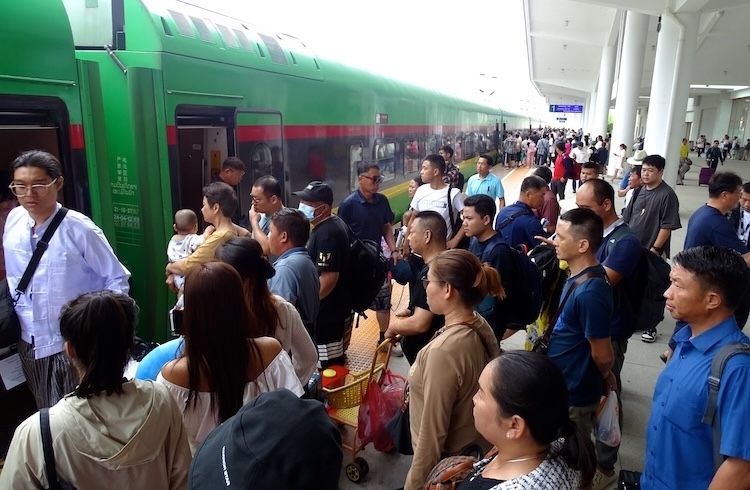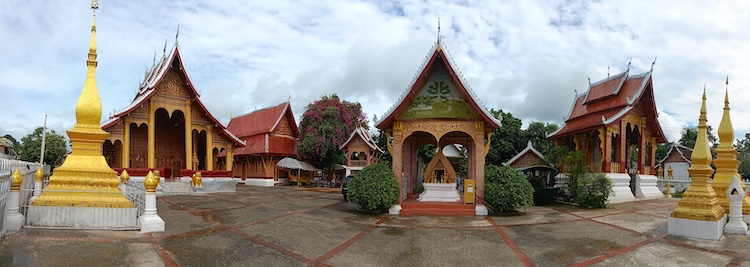By Kalinga Seneviratne
VIENTIANE, Laos | 15 July 2024 (IDN) — Laos, the land-locked country of 7.5 million people, with scenic mountainous terrain, traversed by the Mekong River that flows through both Vientiane and the UNESCO World Heritage Buddhist city of Luang Prabang, and home to many remote hill tribes is now in the crest of a tourism boom spurred by the Chinese-built 414 km long high-speed railway network.
This is a far cry from what the Americans did to them over a half-century ago, when Laos became one of the most heavily bombed countries in the world, during the Vietnam War.
Between 1964 and 1973 a secret CIA-led operation to cut supplies to the Vietcong resulted in two million tons of ordinance being dropped on Laos—more than the combined total dropped on both Japan and Germany during World War Two. Up to this date many areas in the mountainous countryside are inhabitable due to the dangerous UXO (unexploded ordnance) left behind by American bombing, and no reparations have been paid for this.
Yet, the Americans and the western media are quick to criticize Chinese-funded projects such as the railway in Laos that is trying to reverse the damage done by such war crimes.
The China-built railway across land-locked Laos costing $5.9 billion is the linchpin of the expanding connectivity across Southeast Asia—a technological masterpiece that is becoming a major advertisement for China’s Belt and Road Initiative (BRI) and its stated objective of encouraging economic development of the regions. One of the spin-offs of this connectivity is the expansion of tourism.
It’s not only Laotians who are now patronizing the trains in droves, but also Chinese tourist who come across the border in greater numbers.
Economics Professor and Vice President of The National University of Laos, Phouphet Kyophilavong, told IDN that the railway is “a big opportunity in terms of economic development” that is attracting a lot of FDIs (foreign direct investments) from China and other countries. “Even in low season now there are tourists coming to Luang Prabang. That’s good for Laos development in the long term”, he added.

“Since the railway came, more visitors have come to Luang Prabang. Logistically it’s a wonderful project”, Vongdavone Vongxayarth, Deputy Director, Tourism Development Division, Department of Information, Culture, and Tourism of Luang Prabang told IDN.
Luang Prabang, in the centre of Laos and on the banks of the Mekong River, is an UNESCO Heritage Site because of its rich Buddhist architecture and living culture. Buddhism is a thriving religion here, with most people practising it on a daily basis, judging by the early morning tradition of hundreds of yellow-robed monks going on their daily ‘pinapath’ (begging bowl) round to collect food.
“There’s a lot of Chinese Buddhist community in the Yunan Province (across the border from Boten—where the railway connects with China) and now they come by train on pilgrimage to Luang Prabang. You can see them giving food to monks in the morning to make merit”, says Vongdavone.
Though Laos, since the end of the Vietnam War, has been ruled by a party that is nominally Communist, yet Buddhism is deeply ingrained in their culture and daily lives. The Pha That Luang pagoda in Vientiane believed to have been built in the 3rd century CE is enshrined with a hair relic of the Buddha.
Vongdavone gave the official statistics of tourist arrivals to Luang Prabang in the last 5 months of 2023 and the first 5 months of 2024. There’s been an overall 60 per cent increase, with Chinese arrivals showing a five-fold jump to 62, 256. Once the railway is connected across the Mekong to the Thai rail system, Vongdavone expects to see more Thai pilgrims coming here.
On July 19, a direct train service between Bangkok and Vientiane is expected to be launched on a trial basis. And in May this year, Chinese railways started trial runs of tourist trains from Guiyang, the capital of China’s southwestern province of Guizhou to Laos.
The train, the first of its kind, carried 240 passengers who visited several landmark attractions in Laos, during their eight-day trip. It is expected that these tourist trains would run on a monthly basis soon. Other provinces like Yunnan, Hubei, and Beijing had offered similar tourism products to Laos through the Laos-China railway system.
Pointing out that it is low season for tourism now because of the onslaught of the monsoon rains, Vongdavone says “Chinese visitors are coming by rail even now. We have no low season anymore”.
Luang Prabang cut its tooth in the tourism industry in the past two decades, through western cultural tourists and young adventure backpackers. “Now the main tourists are Chinese and Vietnamese,” says Khamchan, sales manager, Laos Ecotourism Travels, a local company.
He said that individuals, couples and families who visit here from China hire the services of local companies like his. But the larger tour groups that come across by train “don’t really use Laotian companies, Chinese and Vietnamese have invested in hotels, tour agencies, even the guides come from China, and they use transport provided by Chinese owned companies”.
Professor Phouphet does not believe that the Laos tourism sector is disadvantaged by this business practice. “As long as people come, eat in our cafés, there are jobs created. They will buy local products. That’s direct impacts,” he argues.
“You may have seen how Chinese tourists come to morning market in Luang Prabang and buy local produce,” he pointed out. “We need to build partnerships with Chinese chains and improve our standards and services to compete with them. Laos people are now learning Chinese to do business with them.”

Learning Chinese is the new craze for young people in Laos today. At the Vocational School of Language for Communication Hommand (VCLCH), its founder and director Hommala Phensisanavong said that she got over 500 students studying Chinese in her three-year certificate course and only 60 study English.
Chinese investments in Laos are huge and expanding, and it is not just in the tourism sector. I spoke to a number of students studying Chinese at the school, who are teenagers just out of school and come from northern Laos bordering China. They all said that learning Chinese is their first priority for and English could come later.
“I’m learning Chinese because it’s good for my career. There are job opportunities and so many options available to work”, said 20 year old Lawan, who works in a Chinese restaurant in Vientiane while studying at VCLCH. “Chinese tourists come there, and I can communicate with them”.
Second year Chinese language student Sunya says there are a lot of Chinese people in Laos. “If we want to develop the country we need to work in cooperation with China, and that means we learn Chinese.”
“Chinese companies hire our students who have finished two to three semesters of our course because by that time they can converse in Chinese,” says Phensisanavong, adding, “our school is supporting Laos’s economic development by offering these courses”. [IDN-InDepthNews]
Photo (top): Chinese pilgrims


